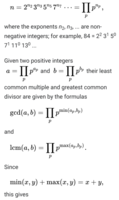Dr.Peterson
Elite Member
- Joined
- Nov 12, 2017
- Messages
- 16,871
Let's get that down to a size I can read all at once rather than filling two screens:

If x=4 and y=6, then min(4,6) = 4, and max(4,6) = 6, right?
So min(x, y) + max(x, y) = 4 + 6 = x + y. One of the numbers has to be the min and the other has to be the max (unless the numbers, are the same, in which case the min and max are the same), so the sum is just the sum of the two numbers.
What you show here is the formal (and far less comprehensible) way to explain the standard method for finding the LCM and GCD using prime factorizations, as stated by pka in post #11.
I can't say for sure why they add them, without seeing what they do next, but I imagine they are using this to prove that LCM(a, b) * GCD(a, b) = ab. Since, once again, you failed to help us out by telling us where to find it, I searched and found it here in Wikipedia. (Why doesn't that surprise me?) And my guess was right. Do you see how they got there?

a subscript p and b subscript p I know it represents each exponent of the each factors but how does the min and max of a subscript p and b subscript p process works.(4,6) take this eg
Why they're adding max of X,y and min of x,y?
If x=4 and y=6, then min(4,6) = 4, and max(4,6) = 6, right?
So min(x, y) + max(x, y) = 4 + 6 = x + y. One of the numbers has to be the min and the other has to be the max (unless the numbers, are the same, in which case the min and max are the same), so the sum is just the sum of the two numbers.
What you show here is the formal (and far less comprehensible) way to explain the standard method for finding the LCM and GCD using prime factorizations, as stated by pka in post #11.
I can't say for sure why they add them, without seeing what they do next, but I imagine they are using this to prove that LCM(a, b) * GCD(a, b) = ab. Since, once again, you failed to help us out by telling us where to find it, I searched and found it here in Wikipedia. (Why doesn't that surprise me?) And my guess was right. Do you see how they got there?
